
The group N version
| Obviously, the Renault 5 GT Turbo C405 has raced many national and
world rallye championships, in groups A and N. Its homologation card for
group N (Nº 5262) was introduced in April 1985 and allowed it race until
1995, but of course there are plenty of GT Turbos racing nowadays in other
categories like FN. This page describes the modifications made at the Gr.N
version of the car.
Disclaimer: These modifications are evidently intended for use only in
rally competitions. |
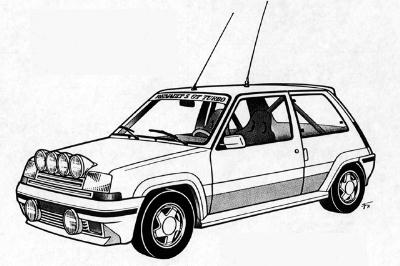 |
The homologation card could be found in:
FFSA
136 Rue de Longchamp
75116 Paris
Tel: +33 1 47 27 97 39
All the specific race parts for Gr. N were available in:
RENAULT ALPINE
Z.I. de Rouxmesnil Bouteilles
76370 ROUXMESNIL BOUTEILLES
Tel: +33 1 35 82 93 14
Fax: +33 1 35 84 54 93
Overview
- Engine capacity 1395 x 1'7 = 2374'9 - Class 10 (2000 to 2500 cc).
- The cars will be strictly from production, following the homologation
card and the maker's data.
- The minimum weight of the car will be the written in the homologation
card plus the safety equipment. For the measure no people will be in the car
and all baggage, supplementary lamps, tools and jack will be removed.
The fuel and windscreen washer tank will be empty and the other tanks will
be at their normal usage level.
Engine
It's free:
- Head: Helicolis (renewing of defective threads) are allowed.
- Engine supports: The rubber compound is free, but not the number of
supports.
Suggested settings and preparation:
- Head gasket: Reinz (ref. 60 01 006 830).
- Mount the 3 engine supports of a special rubber mixture of increased
'shore' (refs. 77 11 065 509, 77 11 065 510 and 60 01 007 858). Check
often their state. An increased tightening torque of bolt and nuts is suggested:
10 mkg approximately.
Oil system
Suggested settings and preparation:
- Oil sump (ref. 60 01 006 831) with anti-waving plate (ref. 60 01 006 417).
Glue the fixing plate bolts with 'Loctite'.
- Keep the oil level always in the middle of the min. and the max. marks.
|
 |
Fuel and exhaust system
It's free:
- Accelerator cable, with the possibility to use two.
- Carburettor fuel settings.
- Exhaust (the use of additional mounting parts is allowed).
|
Suggested settings and preparation:
- Carburation settings:
- Main jet: 125'5 to 127'5.
- Enrichener: 105 to 110.
- Idle jet: 40 to 42.
- Turbo:
- Make sure the turbines don't touch the turbo housing.
- Adjust the boost regulation as
shown to achieve 650 mbar (9.42 psi) with a rod displacement of 0.4 mm.
- Mounting of the fiber screen is allowed.
- Fuel circuit:
- Fuel pressure: 275 ± 25 mbar (3.98 psi ± 0.36 psi)
(idling engine).
- Check the fuel filter state and change it often.
- Check the fuel pump state.
- Free exhaust line (ref. 77 11 067 455).
|
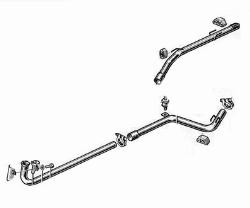 |
Cooling system
It's free:
- Cooling fan switching system (temperature).
- Cooling thermostat.
Suggested settings and preparation:
- Mount a specific electroswitch (ref. 77 11 065 158) in the radiator to
switch on the fan at 83°C.
- Keep the expansion tank at the maximum level.
- Install a switch in the cockpit to activate the cooling fan manually.
- Put the fan as close as possible (2 mm) to the radiator.
- Air filter: Verify the cap air-tightness and change the filtering
element often.
Ignition system
It's free:
- Spark plugs (make and model).
- Rev limiter.
- Lead wire set.
Suggested settings and preparation:
- Inverting the angular position sensor wires the ignition advance is
increased in +3 to +4 degrees. Disconnecting the ground the advance
decreases in 3 degrees.
- Champion spark plugs N3G - N6YC, etc...
Electrical system
It's free:
- All accessories will be allowed as long as they don't have any effect in
the car behaviour, like those concerning inside or outside aesthetic or inside
comfort (lights, heating, radio, etc...), with the condition of not to
change, including any side effect, the mechanical performance of the engine,
the steering, the chassis strength, transmission, braking or handling.
- It's allowed to replace the electrical windows with mechanical ones.
- Battery: Make, capacity, wires, but in the standard place.
- Alternator and belt.
- Relays and fuses.
- Headlamps: Up to eight (the two additional lamps can be covered with
adhesive tape and replaced with another pair).
- It's allowed to move the relay box to properly mount a rollcage.
Suggested settings and preparation:
- Install a 45 Ah battery in the standard one location.
- Alternator: Verify the perfect lining of the water pump and alternator
pulley. Mount a 1160 mm x 9'5 belt, dented if possible. Tension the drivebelt
frequently. Verify the electrical connection state too (see ITRS 64).
- Install the 4 or 6 supplementary headlamps carefully not to block the
radiator or intercooler airflow, fixing the lamp support perfectly to the
front chassis bar to avoid vibrations, drilling previously the front bumper.
- Change all relays often and verify the electrical connections state
(oxidation).
- Install a battery cut out (compulsory from 1987, January the 1st in every
race).
Gearbox
It's free:
Suggested settings and preparation :
- Install the metal-ceramic disk (ref. 77 11 066 644), taking care to
prepare it previously over marble surface to ensure the perfect plainness
of the coupling (noise), in both sides.
- Fix the mechanisms and disk over the flywheel, applying a layer of
'loctite' to the bolts.
- Roll the clutch.
- Fill the gearbox with ELF-tranself TRX 80 W oil (3'2 liters max.) the
gearbox and change it often.
- Change all gearbox bearings and the fixing washer of the differential
(left planet wheel).
- Change often the dented sector of the clutch pedal.
Brakes
It's free:
- Pad compound and fixing system.
- Disk protection plates (removal, deformation).
- Servobrake disconnection.
- The brake hoses can be changed for braided ones.
Suggested settings and preparation:
- Mount FERODO 592 compound pads on front and rear brakes (refs. 60
00 007 951 -front- and 77 11 066 617 -rear-).
- Check the front discs state (risk of disc run-out).
- Change the brake fluid often and use a high temperature one.
- Remove the air deflectors of the rear brake discs. Dismantle the master
cylinder and check its state. Check the Master-Vac rod (clips) state too.
Suspension and steering
Front train
It's free:
- Tyres, on standard wheels.
- Shock absorbers (The spring seat or shape can be modified).
- Springs, bumpstops and washers.
Suggested settings and preparation:
- Tyres: MICHELIN 16.53.13 or PIRELLI 175.510.13 in their different
compounds.
- Tyre pressure: 2.3 bars (33.3 psi).
- Mount the specific springs (ref. 77 11 066 942) in the BILSTEIN shock
absorbers (ref. 77 11 066 923), using all standard parts on the upper side,
painting them to avoid corrosion.
- Mount the BILSTEIN shock absorbers with bumpstops (ref. 77 11 067 209),
and add between them and the shock absorber a 5 mm thick washer on the rod
(ref. 77 11 067 176). Regulate the negative camber angle to 1° 30' max.
- Verify that the steering angle differences between right and left side
are as small as possible.
- The caster angle is not adjustable, but choose suspension triangles that
produce the same value in each side.
- Front body height: 318 mm min., measured with 20 liters of fuel and
pilot inside the car (wheel axis / front wing border).
- Re-tighten after every race the steering rod nut.
- Verify in every assistance the right and left driveshaft nut tightening.
Rear train
It's free:
- Tyres over standard wheels.
- Shock absorbers, bumpstops and washers.
- Torsion and anti-roll bars (diameter).
Suggested settings and preparation:
- Tyres: MICHELIN 16.53.13 or PIRELLI 175.510.13 in their
different compounds.
- Tyre pressure: 1.9 bars (27.5 psi).
- Resold the upper and lower rear shock absorber mountings.
- Mount the specific shock absorbers (ref. 77 11 067 369) in the car,
with bumpstops (ref. 77 11 067 451) and a 10 mm thick washer (ref.
77 11 067 177).
- Remove the torsion bars (trailing arms), mount the specific ones
(refs. 77 00 758 855 -left- and 77 00 758 856 -right-) and ensure a free
sliding.
- Remove the anti-roll bars, mount the specific ones
(refs. 77 11 066 925 -left- and 77 11 066 926 -right-).
- Adjust the rear body height using the torsion bars:
1 dent = 8mm more/less height. See Renault T. N. 1095 (ref. 77 11 077 889).
- Rear chassis height: 295 mm minimum with 20 liters of fuel and pilot in
the car (wheel axis / rear wing border).
- Control the right placement of the 4 suspension bars.
- Verify the rear axle alignment with the front axle.
Body
It's free:
- All suspended part reinforcement as long as the added stuff has the
shape of the standard one and is in contact with it.
- Front and rear suspension strut bars, removable.
- Lower protections mounting under the engine, radiator, suspension,
gearbox, tanks, driveshafts, exhaust, but they must be removable.
Suggested settings and preparation :
- Reinforce the chassis as RENAULT SPORT Nº 42 note suggests: To
achieve good quality soldering cords, it's suggested to start over a
non-blacksoneed non-treated chassis, available in the competition part
catalog (ref. 77 11 066 886), but it's also possible to do it from a
standard chassis (ref. 77 01 463 559), being careful to remove the
blackson to let naked plate.
Make all the soldering work following the schemes and add the
reinforcements showed so that the added material adapts to the standard
shape and it's in contact with it. The soldering will be done with a TIG or
MIG equipment, with a 20 to 30 mm cord length and a 30 to 40 mm separation.
- Install the Matter front strut bar (ref. 77 11 066 640), bolted over the
shock absorber upper mounting. Check that the bar doesn't touch the
carburettor head.
- Engine subframe (refs. 77 11 066 947 -gravel- or 77 11 068 334
-asphalt-).
- Front sump protection (refs. 77 11 066 946 -gravel- or 77 11 068
335 -asphalt-).
|
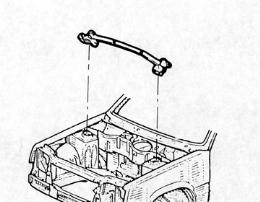 |
Other fittings
It's free:
- Helmet box.
- Flying handbrake.
- Competition seat (standard seat weight 12 kgs).
- Sump protection.
- Fuel filler cap.
- Headlamp protection (no aerodynamical changes).
- Installation of the standard spare wheel (free tyre) in the boot.
- Steering wheel.
- All accessories not changing the car handling, and all measure gauges.
It's suggested:
- At least two supplementary locks in the bonnet and tailgate (standard
ones suppressed).
- Windsreen safety fixings.
- Fuel tank FT 3 (50 liters) with pump, filter and protection installed in
the boot.
- The rear seat can be tilted or modified (hose pass). It's allowed to
install protection sleeves on the hoses.
It's compulsory:
- Security harnesses: minimum 3 fixing points to the body. FIA
homologation nº 8854 or 8853.
- Fire extinguisher: at least a 4 kg one. Halon 1211 or 1301 powder or similar,
in two containers as maximum, with quick release metallic retaining straps.
- Rollcage conforming the homologation card. To install it, modification of
the dashboard and lateral covers is allowed.
|
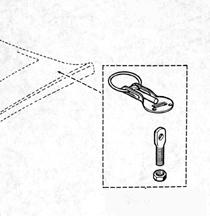
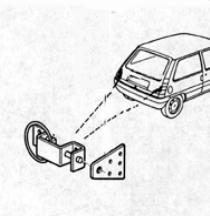
|
Notes:
- When installing the rollcage in the car, be careful not to damage the
electrical wires or fuel hoses. Do it, if possible, with the body tied
to a body vice.
- When mounting the sump protection, ensure an important free play between
the gearbox command rod and the protector sump cover (1 cm).
- To mount the supplementary headlamps on the front bumper, it's necessary
to reinforce the bumper-front chassis bar union to avoid vibrations.
- Fix the number plate over the spoiler as high as possible, to increase
the airflow.
Phase 2 specific settings
|
Front axle:
- Toe-out: 1 mm.
- Negative camber angle: 1°15' to 1° 30'.
- Front body height: 315 mm min., measured with 20 liters of fuel and
pilot inside the car (wheel axis / front wing border).
- Specific springs (ref. 77 11 067 349).
- Specific shock absorbers (ref. 77 11 067 360).
- Shock absorber bumpstops (ref. 77 11 067 209) of length 87 mm corrected
as figure below and mounted with a 10 mm thick washer (ref. 77 11 067
177) on the rod.
|
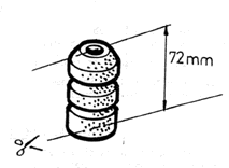 |
|
Rear axle:
- Rear chassis height: 290 mm minimum with 20 liters of fuel and pilot in
the car (wheel axis / rear wing border).
- Same rubber bumpstop as phase 1 (ref. 77 11 067 451).
Note: See homologation card extensions 05/02 and 17/01.
|






